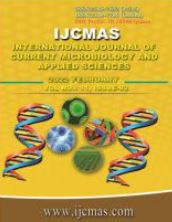


 National Academy of Agricultural Sciences (NAAS)
National Academy of Agricultural Sciences (NAAS)

|
PRINT ISSN : 2319-7692
Online ISSN : 2319-7706 Issues : 12 per year Publisher : Excellent Publishers Email : editorijcmas@gmail.com / submit@ijcmas.com Editor-in-chief: Dr.M.Prakash Index Copernicus ICV 2018: 95.39 NAAS RATING 2020: 5.38 |
Purpose: Present investigation was aimed at characterization of pathomorphological lesions in the Low Doses Alloxan-STZ Diabetic Rabbit Model. Method: New Zealand White rabbits, 1-1.5 kg body weight, were administered alloxan (@50mg/kg b.w) and STZ (@35mg/kg b.w) cocktail, as single intravenous dose followed by glucose therapy after 9 hours. Blood glucose was regularly monitored and with blood glucose >200mg/dl on day 7 following drug administration were used for study. Two rabbits each were sacrificed fortnightly from days 15 to 60 for pathoanatomical investigation. Results: Gross lesions included congestion, and haemorrhages in different organs. Histopathologically, pancreas revealed variable degeneration and loss of beta-cells in the islets; and acinar cell degeneration. Changes were milder at later stages. Liver revealed vascular congestion, progressive hepatosis, portal triaditis, and presence of binucleated hepatocytes. During later stage hepatocellular necrosis was seen. Kidneys revealed vascular congestion; focal haemorrhages; cortical tubular degeneration and necrosis; lower nephron nephrosis; glomerular congestion and hypersegmentation; mesangial cell hyperplasia and focal nephritis with mononuclear cell infiltration. Later, peritubular fibroplasias; glomerular hypertrophy with vacuolation of podocytes and fragmentation; and casts in collecting tubules were seen. Brain revealed neuronal degeneration and necrosis in cerebral cortex, caudoputamen, different areas of hippocampus including dentate gyrus and Cornu Ammonis especially pyramidal cells of CA4 region, subiculum and brain stem; demyelination and gliosis in medullary tracts; mild purkinje cell degeneration and karyorrhexis in cells of granule layer; choroid epithelial degeneration; and vascular congestion. Lungs revealed vascular congestion, haemorrhages, emphysema, atelectasis, peribronchial lymphoid hyperplasia, focal pneumonia, hypertrophy of vascular walls, vacuolation of pneumocytes and presence of numerous alveolar macrophages. Heart showed vascular congestion, focal haemorrhages and degeneration of cardiomyocytes. Spleen revealed congestion, haemorrhage, apoptosis of lymphoid cells, and vacuolation of reticular cells. histiocytic reaction was additionally noted in MLNs. Congestion, degeneration and necrosis were seen in zona glomerulosa and zona fasciculate of adrenal-cortex and also, in adrenal-medulla. Changes in testes were characteristic of arrested spermatogenesis, and degeneration and apoptosis of spermatocytes. Conclusion: It could be concluded that the progressive and marked pathomorphological alterations suggest Alloxan-STZ diabetic rabbits shall be a good short term model for diabetes associated investigation when weighed appropriately against internal control.
 |
 |
 |
 |
 |